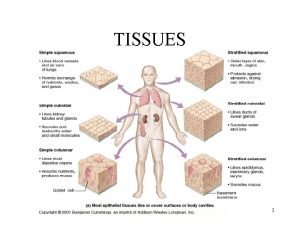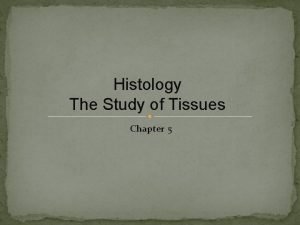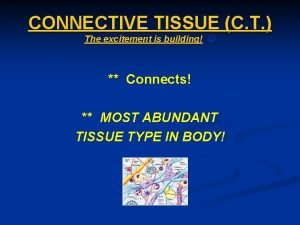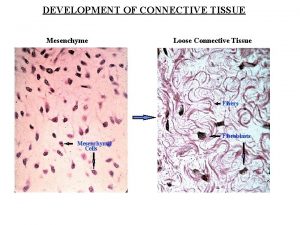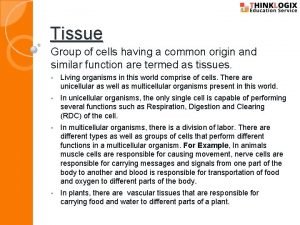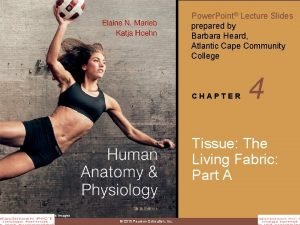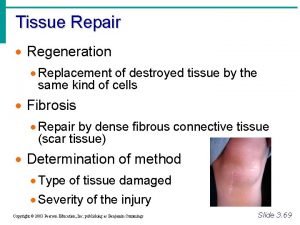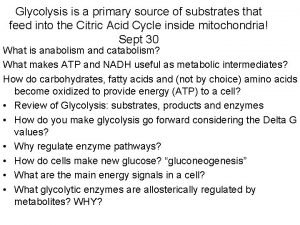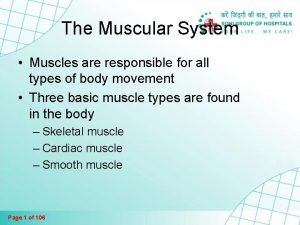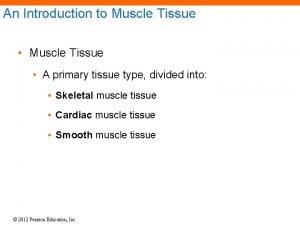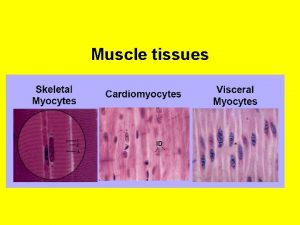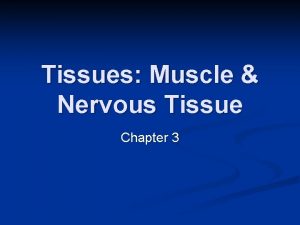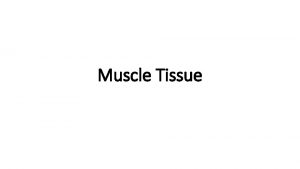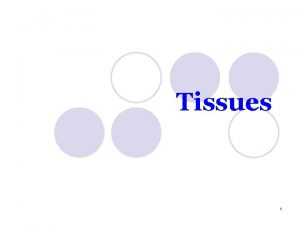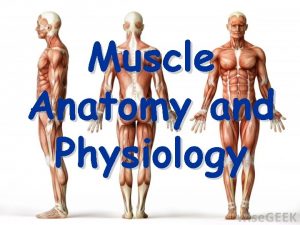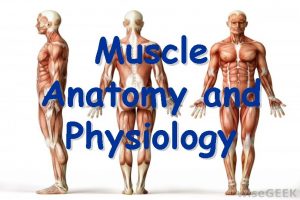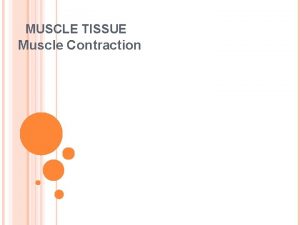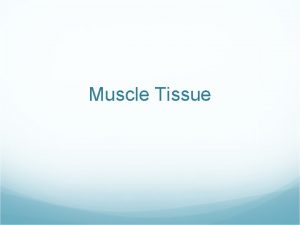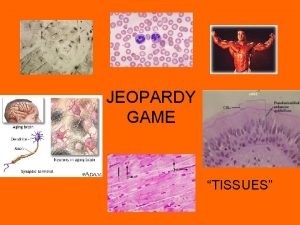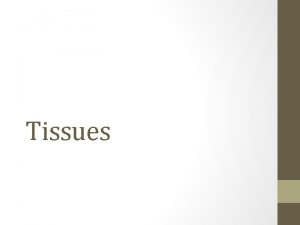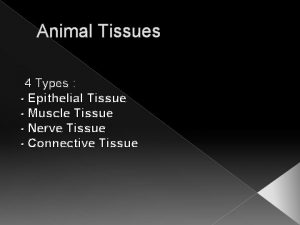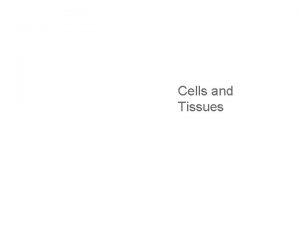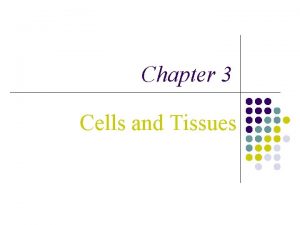Muscle tissues Muscle tissue Muscle cells myocytes are




![Smooth muscle is an involuntary [non-[striated muscle]]. It is divided into two sub-groups; the Smooth muscle is an involuntary [non-[striated muscle]]. It is divided into two sub-groups; the](https://slidetodoc.com/presentation_image_h2/d6b37e029efc7128b2c98cf3b56b91a1/image-5.jpg)



































- Slides: 40

Muscle tissues

Muscle tissue • Muscle cells (myocytes) are elongated and classified and or compatible as either striated muscle cells or smooth muscle cells depending on the presence or absence, respectively, of organized, regularly repeated arrangements of myofibrillar contractile proteins called myofilaments. Striated muscle is further classified as either skeletal or cardiac muscle. [1] Thus, muscle tissue can be described as being one of three different types:

Muscle tissue • Skeletal muscle or "voluntary muscle" is anchored by tendons (or by aponeuroses at a few places) to bone and is used to effect skeletal movement such as locomotion and in maintaining posture. • Though this postural control is generally maintained as an unconscious reflex (see proprioception), the muscles responsible react to conscious control like non-postural muscles. • An average adult male is made up of 42% of skeletal muscle and an average adult female is made up of 36% (as a percentage of body mass). [2] It also has striations unlike smooth muscle. • Smooth muscle or "involuntary muscle" is found within the walls of organs and structures such as the esophagus, stomach, intestines, bronchi, uterus, urethra, bladder, blood vessels, and the arrector pili in the skin (in which it controls erection of body hair). • Unlike skeletal muscle, smooth muscle is not under conscious control.

![Smooth muscle is an involuntary nonstriated muscle It is divided into two subgroups the Smooth muscle is an involuntary [non-[striated muscle]]. It is divided into two sub-groups; the](https://slidetodoc.com/presentation_image_h2/d6b37e029efc7128b2c98cf3b56b91a1/image-5.jpg)
Smooth muscle is an involuntary [non-[striated muscle]]. It is divided into two sub-groups; the single-unit (unitary) and multiunit smooth muscle. Within single-unit smooth muscle tissues, the autonomic nervous system innervates a single cell within a sheet or bundle and the action potential is propagated by gap junctions to neighboring cells such that the whole bundle or sheet contracts as a syncytium (i. e. , a multinucleate mass of cytoplasm that is not separated into cells). Multiunit smooth muscle tissues innervate individual cells; as such, they allow for fine control and gradual responses, much like motor unit recruitment in skeletal muscle. http: //en. wikipedia. org/wiki/Smooth_muscle_tissue

• Smooth muscle is found within the walls of blood vessels (such smooth muscle specifically being termed vascular smooth muscle) such as in the tunica media layer of large (aorta) and small arteries, arterioles and veins. • Smooth muscle is also found in lymphatic vessels, the urinary bladder, uterus (termed uterine smooth muscle), male and female reproductive tracts, gastrointestinal tract, respiratory tract, arrector pili of skin, the ciliary muscle, and iris of the eye. • The structure and function is basically the same in smooth muscle cells in different organs, but the inducing stimuli differ substantially, in order to perform individual effects in the body at individual times. • • In addition, the glomeruli of the kidneys contain smooth muscle-like cells called mesangial cells.

3. 1. 2. 1. - gludā muskuļa šūnas, 2. - muskuļšūnas kodoli, 3. -saistaudi

Morfoloģiskās pazīmes: Vārpstveida šūnas, saplacināti kodoli, eozinofila citoplazma, bazofili kodoli

• • Venules sieniņa L - lumens, E - endotelijs, M – gludo muskuļu šūna, C – kolagēna šķiedras. Mērgs = 2 µm. (Rabbit, neocortex. ) http: // synapses. bu. edu/atlas/3_7. stm

Arteriolas sieniņa. L - lumens, E - endotelijs, M – gludo muskuļu šūna. Mērogs = 1 µm. (Rat, thalamus. ) http: //synapses. bu. edu/atlas/3_8. stm

• • Arteriolas sieniņa. B – bazālā plātnīte, E - endotelijs, M – gludo muskuļu šūna, C- kolagēna šķiedras. Mērogs = 200 nm. (Mouse, neocortex. ) http: //synapses. bu. edu/atlas/3_9. stm

Spraugveida kontakti gludo muskuļu šūnās.

• Smooth muscle is found within the walls of blood vessels (such smooth muscle specifically being termed vascular smooth muscle) such as in the tunica media layer of large (aorta) and small arteries, arterioles and veins. • Smooth muscle is also found in lymphatic vessels, the urinary bladder, uterus (termed uterine smooth muscle), male and female reproductive tracts, gastrointestinal tract, respiratory tract, arrector pili of skin, the ciliary muscle, and iris of the eye. • The structure and function is basically the same in smooth muscle cells in different organs, but the inducing stimuli differ substantially, in order to perform individual effects in the body at individual times. • In addition, the glomeruli of the kidneys contain smooth muscle-like cells called mesangial cells.

• • Smooth muscle Bundles of actin microfilaments Myosin miofilaments Dense plaque Dense boodies Nucleus Cytoplasm Gap juctions Cell Signalling Biology - Michael J. Berridge www. cellsignallingbiology. org - 2012 http: //www. biochemj. org/csb/frame. htm

Smooth muscle



Smooth muscle and plasma membrane Smooth muscle http: //www. biochemj. org/csb/007/Fig 7_smooth_muscle_cell_EC-couplinga. jpg Module 7: Figure smooth muscle cell EC coupling

Gludo muskuļu kontrakcijas. MLCK-myosin, light chain kinase, Ca 4 CM – Ca and calmodulin complex komplekss.


Sceletal striated muscle tissue

Muscle fibers • Red Muscle fibers : Mitochondria, Prolongated activity • White Muscle fibers Anaerobic respiration • Short activity

M-M line, Z- Z line, I- I band, A- A band, H- H band endomysium perimysium


• sarcomere.

• Thin and thick miofilaments


Triads http: //www. youtube. com/watch? v=WVu. W 560 n. RII


Cell Signalling Biology - Michael J. Berridge - www. cellsignallingbiology. org - 2012

Cardiomiocytes







Muscle contractions http: //www. cellsalive. com/myocyte. htm


 The four major categories of tissues are
The four major categories of tissues are Body tissues chapter 3 cells and tissues
Body tissues chapter 3 cells and tissues Cells form tissues. tissues form __________.
Cells form tissues. tissues form __________. Body tissues chapter 3 cells and tissues
Body tissues chapter 3 cells and tissues Anatomy chapter 3 cells and tissues
Anatomy chapter 3 cells and tissues Mikael ferm
Mikael ferm Divisions of anatomy
Divisions of anatomy Tissues are groups of similar cells working together to:
Tissues are groups of similar cells working together to: Chapter 3 cells and tissues
Chapter 3 cells and tissues Tissues are groups of similar cells working together to
Tissues are groups of similar cells working together to Chapter 3 cells and tissues figure 3-1
Chapter 3 cells and tissues figure 3-1 Tissues are groups of similar cells working together to
Tissues are groups of similar cells working together to Anatomy of a generalized cell figure 3-1 answer key
Anatomy of a generalized cell figure 3-1 answer key Chapter 8 cellular reproduction cells from cells
Chapter 8 cellular reproduction cells from cells Venn diagram for animal and plant cells
Venn diagram for animal and plant cells Pseudostratified vs simple columnar
Pseudostratified vs simple columnar Somatic cells vs germ cells
Somatic cells vs germ cells Cell substance
Cell substance Prokaryotic cells vs eukaryotic cells
Prokaryotic cells vs eukaryotic cells Onodi cells
Onodi cells What cell type
What cell type Chlorocruorin
Chlorocruorin Organelle trail
Organelle trail Thyroid parafollicular cells
Thyroid parafollicular cells Alpha intercalated cell
Alpha intercalated cell Prokaryotic cells vs eukaryotic cells
Prokaryotic cells vs eukaryotic cells Prokaryotic vs eukaryotic cells
Prokaryotic vs eukaryotic cells Masses of cells form and steal nutrients from healthy cells
Masses of cells form and steal nutrients from healthy cells Haploid and diploid venn diagram
Haploid and diploid venn diagram Reticuloendothelial tissue is composed of cells that are
Reticuloendothelial tissue is composed of cells that are Cells and fibres of connective tissue
Cells and fibres of connective tissue What functions of
What functions of Mesenchymal tissue
Mesenchymal tissue Tissue is a group of cells having
Tissue is a group of cells having Mucous connective tissue umbilical cord
Mucous connective tissue umbilical cord Simple cuboidal epithelium description
Simple cuboidal epithelium description Replacement of destroyed tissue
Replacement of destroyed tissue Perforation plates
Perforation plates Glycolysis in muscle cells
Glycolysis in muscle cells Different types of muscle cells
Different types of muscle cells Terminal cisterna
Terminal cisterna











